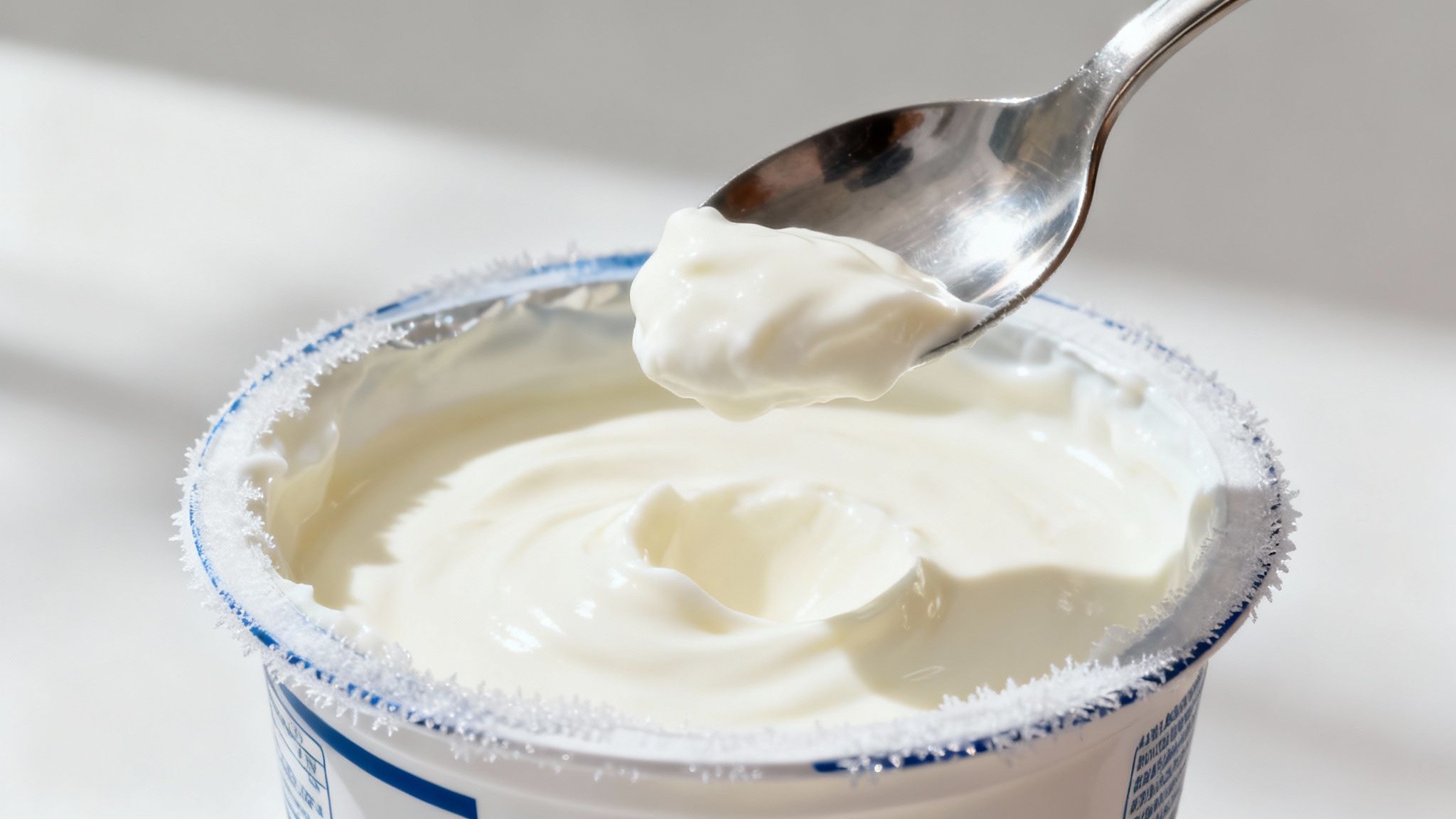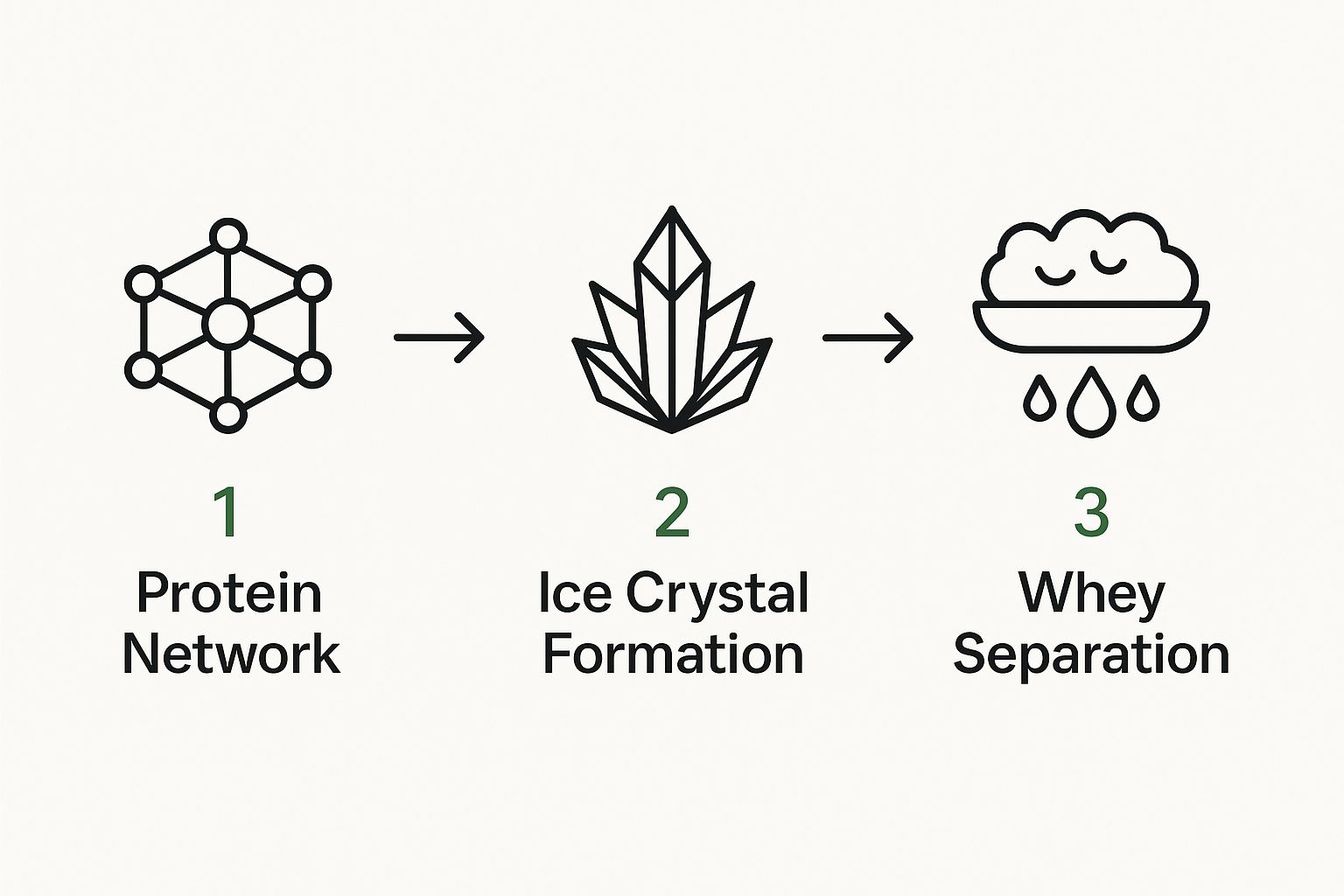Yes, you absolutely can freeze Greek yogurt. It's a fantastic way to extend its shelf life and cut down on food waste. But, there's a catch you need to know about—freezing will definitely change its signature creamy texture.
What Happens When You Freeze Greek Yogurt
If you've ever wondered why Greek yogurt gets weird after a trip to the freezer, it all comes down to simple science. Greek yogurt is packed with water, mostly in the form of whey. When you freeze it, this water forms sharp little ice crystals that mess with the delicate protein structure that gives the yogurt its thick, smooth consistency.

Once you thaw it out, the yogurt's original texture is pretty much gone. The whey (the liquid part) separates from the solids, leaving you with a consistency that’s often:
- Grainy or gritty: Those broken protein structures just don't feel as smooth.
- Thinner or watery: With the whey separated out, the yogurt loses a lot of its original thickness.
But here's the good news: this transformation is purely textural. Freezing doesn't touch the safety or nutritional profile of the yogurt one bit. You’ll still get all that great protein and those probiotic benefits. Both scientific studies and consumer reports confirm that while freezing causes whey separation and changes the feel, the yogurt is perfectly safe and healthy to eat. You can dive deeper into the properties of frozen Greek yogurt and its market trends over at dataintelo.com.
Key Takeaway: Freezing Greek yogurt is a safe and practical way to make it last longer. The only real downside is a change in texture, not a loss in nutritional value.
To give you a clearer picture of what to expect, here’s a quick side-by-side look.
Greek Yogurt Before And After Freezing
This table breaks down the key differences between fresh Greek yogurt and what it's like after being frozen and thawed.
| Attribute | Fresh Greek Yogurt | Frozen & Thawed Greek Yogurt |
|---|---|---|
| Texture | Thick, creamy, and smooth | Potentially grainy, thin, or separated |
| Appearance | Uniform and consistent | May look watery with visible liquid |
| Taste | Rich and tangy | Flavor remains similar, but tanginess might seem more pronounced |
| Best For | Eating plain, as a topping | Smoothies, baking, marinades, cooked sauces |
Ultimately, while you probably won't want to eat a bowl of previously frozen Greek yogurt on its own, it's still an incredibly useful ingredient to have on hand for all sorts of recipes.
Why Freezing Changes Your Yogurt's Texture
Ever wondered what’s actually happening inside that container when you pop Greek yogurt into the freezer? The secret to its incredible creaminess isn't magic—it's all about its protein structure. Think of this structure as a tightly woven, microscopic sponge that's an expert at holding onto water and whey.
When your yogurt is fresh, this protein network is strong and stable, giving you that signature smooth, thick texture we all love. But the moment you introduce freezing temperatures, you throw that delicate balance completely out of whack. The water molecules trapped inside the yogurt start forming sharp, jagged ice crystals.
These ice crystals are the real culprits here. They act like tiny knives, puncturing and shredding the delicate protein mesh. The longer the yogurt stays frozen, the bigger these crystals can get, causing even more damage to its internal structure. This process is exactly why the answer to "can you freeze Greek yogurt?" isn't a simple yes or no.
The Thawing Aftermath
So what happens when you move the yogurt back to the fridge? As the ice crystals melt back into water, you're left with a problem. The protein "sponge" is now torn up and can no longer hold onto that liquid as well as it once did.
This infographic breaks down the simple, three-step journey from creamy to separated.

As you can see, the once-stable network gets compromised by ice, which leads directly to the whey separating. The result is that liquid whey seeps out, leaving you with a watery, slightly clumpy mixture.
The result? A thawed yogurt that often looks grainy, thin, and pretty unappealing. The whey and the solids, which used to be perfectly blended, are now doing their own thing. That's why a quick stir rarely brings it back to its former glory.
Understanding this physical change is the key to successfully using frozen Greek yogurt. It helps set your expectations and guides you toward the best ways to use it, especially in recipes where a little texture change won't matter one bit.
How to Freeze Greek Yogurt for the Best Results
Okay, so now that we've covered the science behind why Greek yogurt's texture goes a bit wonky in the freezer, let's get into the practical side of things. How do you actually freeze it to get the best possible results? The right technique can make all the difference, minimizing those pesky ice crystals and keeping as much of its creamy goodness as possible.
Your game plan will really depend on how you plan to use the yogurt down the road.

But before you do anything else, there's one crucial first step: whisk the yogurt vigorously. Seriously, give it a good, hard whip. This helps tighten up its protein structure, creating a more stable emulsion that’s less likely to separate into a watery mess when it thaws.
Freezing in Individual Portions
For sheer convenience, you can't beat the ice cube tray method. It’s perfect if you're planning to toss a bit into smoothies or need single-serving amounts for recipes. This approach gives you perfectly portioned pucks of yogurt, ready to grab whenever you need them.
Freezing food in smaller, manageable chunks is a fantastic way to cut down on waste—a trick that works for all sorts of things. If you're into preserving produce, our guide on how carrots can be frozen has some similar tips.
- Spoon and Smooth: Grab a standard ice cube tray and fill each compartment with your whisked yogurt. Use a spatula to smooth out the tops.
- Freeze Solid: Pop the tray into the freezer for at least 4-6 hours. You want the cubes to be frozen solid all the way through.
- Store for Later: Once they're frozen, pop the yogurt pucks out and toss them into a freezer-safe bag or an airtight container. Don't forget to label it with the date!
This method is a winner because the small portions freeze much faster, which means smaller ice crystals and less damage to the texture.
Pro Tip: Before you freeze, press a layer of plastic wrap directly onto the surface of the yogurt in the tray. This simple barrier helps prevent freezer burn and stops those big, crunchy ice crystals from forming on top.
Freezing a Full Container or Making Yogurt Bark
If you've got a whole tub you need to save, you can freeze it right in its original container, as long as it’s not filled to the brim (you need to leave some room for expansion). Just like before, give it a thorough whisk first and press plastic wrap against the surface.
Or, for a ridiculously easy and delicious frozen treat, try making yogurt bark. Spread a thin layer of Greek yogurt on a baking sheet lined with parchment paper, sprinkle on toppings like berries, nuts, or granola, and freeze until solid. Once it's hard, just break it into pieces. It’s a healthy snack that hits the spot just like ice cream.
The Best Way to Thaw and Revive Your Yogurt
So, you've got a frozen block of Greek yogurt. Now what? Bringing it back to its creamy glory is all about patience. If you rush the process, you'll wreck the texture and potentially compromise food safety. The golden rule here is simple: go slow.
The absolute best way to thaw it is to move the container from your freezer straight to the fridge. This slow, gradual temperature change is gentle on the yogurt's delicate protein structure, which helps minimize the watery separation you’ll see. Give it time—a standard container can easily take a full 24 hours to thaw completely.
Whatever you do, never, ever thaw Greek yogurt in the microwave or leave it sitting on the counter. The microwave creates angry hot spots that will literally cook the yogurt, turning it into a lumpy, rubbery mess. And letting it thaw at room temperature is just asking for bacterial growth, making it unsafe to eat. This slow-thaw principle applies to a lot of frozen dishes, like the one we cover in our guide on whether you can freeze baked macaroni and cheese.
How to Fix That Watery Texture
Once your yogurt has fully thawed in the fridge, you'll probably notice it looks thin and watery. That’s just the whey separating from the solids. Don’t panic—this is completely normal and totally fixable. The trick is to get that liquid mixed back into the yogurt.
The goal isn’t just to thaw the yogurt, but to revive it. Think of it as re-emulsifying a broken sauce; you need to force the separated components back together to restore its creamy nature.
To get that smooth consistency back, you'll need to put a little energy into it. Here are two of the most effective ways to do it:
- Whisk It Good: For smaller amounts, a simple wire whisk is your best friend. Get the yogurt in a bowl and whisk it vigorously for at least a minute. This forceful motion helps the proteins reabsorb all that whey, leaving you with a much creamier, more cohesive yogurt.
- Bring Out the Blender: If you're working with a big batch or just want the absolute smoothest result possible, a blender or an immersion blender is the way to go. A few quick pulses will bring it all back together beautifully, making it perfect for smoothies, dips, or sauces.
After a good whisk or blend, your yogurt is ready to use. While it might not be exactly the same as it was fresh from the store, it'll be more than smooth enough for countless delicious recipes.
Clever Ways to Use Thawed Greek Yogurt

So, your thawed Greek yogurt looks a little… different. Don't worry. That slightly altered texture isn’t a flaw—it’s an opportunity to get creative in the kitchen. Instead of trying to force it back to its original state for eating plain, lean into recipes where its new consistency is a total non-issue, or even an advantage.
This mindset is a game-changer for cutting down on waste, a core principle behind smart food waste reduction strategies. Think of your thawed yogurt as a secret ingredient for adding moisture, a protein boost, and a subtle tang to a whole host of dishes. It truly shines in anything cooked or blended.
Perfect for Baking and Batters
One of the absolute best homes for thawed Greek yogurt is in your baked goods. When you mix it into batters for muffins, quick breads, or pancakes, that slightly runnier texture blends in seamlessly.
What you get is incredible moisture and a tender crumb that milk alone just can't deliver. The yogurt's natural acidity also reacts with baking soda, giving your treats a fantastic lift for a light, airy result. It's an easy, one-for-one substitute for sour cream or buttermilk in most recipes.
The global Greek yogurt market was valued at USD 8.6 billion and is projected to hit USD 19.82 billion by 2032. This boom is happening because consumers are finding all sorts of versatile uses for it—including freezing it to preserve its nutritional punch for snacks and cooking. You can dig into more data on the growing Greek yogurt market.
Soups, Sauces, and Marinades
Thawed Greek yogurt is also a star player in savory dishes. Once it's blended or heated, that slightly separated texture completely disappears.
- Creamy Soups: Swirl it into a pot of tomato or lentil soup right at the end of cooking. You’ll get a rich, creamy finish without the heaviness of actual cream.
- Tenderizing Marinades: The lactic acid in Greek yogurt is a powerhouse for marinades, especially for chicken, lamb, or pork. It gently breaks down the proteins, leaving you with unbelievably tender and juicy meat.
- Flavorful Dressings: Blend it with fresh herbs, a squeeze of lemon juice, and some garlic for a healthy, tangy dressing that's perfect for salads or as a dip for veggies.
To make it even easier, here's a quick guide to help you decide where your thawed yogurt will perform best.
Best Uses For Thawed Greek Yogurt
| Application | Why It Works | Example Recipe |
|---|---|---|
| Baking | Adds moisture and tenderness; the altered texture incorporates easily into batters. | Blueberry Muffins, Banana Bread |
| Pancakes & Waffles | Creates a light, fluffy texture and adds a subtle tang. | Fluffy Buttermilk-Style Pancakes |
| Soups | Provides a creamy finish without curdling when added off-heat. | Creamy Tomato Basil Soup |
| Marinades | Lactic acid tenderizes meat, making it incredibly juicy and flavorful. | Greek Lemon Chicken Skewers |
| Smoothies | Blends perfectly, adding protein and creaminess. The texture change is unnoticeable. | Mixed Berry & Spinach Smoothie |
| Dips & Dressings | A quick whisk or blend makes it smooth enough for a tangy base. | Herbed Yogurt Ranch Dressing |
By embracing these simple uses, you can feel confident that you're not just saving yogurt from the bin—you're turning it into something delicious. The answer to "can Greek yogurt be frozen" is always a confident and resourceful yes.
Make Frozen Greek Yogurt Your Go-To Healthy Dessert
Instead of stressing about how to thaw Greek yogurt, what if you just leaned into its frozen state? This little mind trick opens up a whole world of incredible, healthy desserts that give traditional ice cream a serious run for its money. It's the perfect way to crush a sweet craving without the guilt.
When you put frozen Greek yogurt head-to-head with typical ice cream, the health benefits are impossible to ignore. Greek yogurt is a protein powerhouse, which is exactly what you need to feel full and satisfied. A single cup can pack over 20 grams of protein, while most ice creams barely offer 2-5 grams. That makes it a much smarter, more filling treat.
Plus, when you make it yourself, you're in complete control of the sugar. You can sweeten it up with a drizzle of honey, a little maple syrup, or some fresh fruit, easily sidestepping the massive amounts of added sugar hiding in most store-bought desserts.
Crafting Your Own Frozen Yogurt
Whipping up your own frozen Greek yogurt couldn't be simpler. Seriously, all you need is some plain Greek yogurt and whatever flavors you're in the mood for. No fancy gadgets required.
- Whisk Your Base: Grab a bowl and whisk your Greek yogurt with your sweetener of choice until it's nice and smooth.
- Add Your Mix-Ins: Now for the fun part. Gently fold in your favorite goodies—think fresh berries, dark chocolate chips, or a swirl of peanut butter.
- Freeze Until Firm: Pour the mixture into a container that’s safe for the freezer. Let it chill for at least 4-6 hours, or until it's firm enough to scoop.
This whole movement toward healthier frozen treats isn't just a fad; it's a major shift in how we think about dessert. The global frozen yogurt market has blown up, with North America gobbling up nearly half of the market share. This boom is tied directly to people actively looking for desserts with less fat, more protein, and the bonus of good-for-your-gut probiotics.
Once you nail the basic recipe, you can really start having fun with it. Experiment with different flavor combos or try shaping it in new ways. You can whip up some fun and healthy creative frozen yogurt treats like these frozen yogurt dots for a perfect bite-sized snack. Whether you’re making scoops, popsicles, or a fancy yogurt bark, freezing turns this everyday staple into a genuinely exciting dessert experience.
Frequently Asked Questions About Freezing Yogurt
So, you're ready to start freezing your Greek yogurt, but a few questions are probably popping into your head. That's completely normal. Let's walk through some of the most common ones so you can feel confident turning your freezer into your personal yogurt bank.
How Long Can You Keep Greek Yogurt in the Freezer?
For the best possible quality, you’ll want to use your frozen Greek yogurt within one to two months. While it’s still perfectly safe to eat beyond that, the texture and flavor can start to go downhill a bit more noticeably.
A simple pro-tip? Grab a marker and label every container with the date you froze it. This little step saves you from playing "guess the freezer food" later and ensures you're always using your yogurt at its peak.
Key Insight: Think of freezing as hitting the pause button, not a time machine. The sooner you use your yogurt, the closer it will be to its original, delicious self when you thaw it.
Does Freezing Greek Yogurt Kill the Probiotics?
This is a fantastic question, and the answer will make your gut happy: No! Freezing doesn't kill off those beneficial live and active cultures in your Greek yogurt. Instead, it just puts them into a dormant state—think of it like they're hibernating through a long winter.
Once you thaw the yogurt, those helpful little bacteria wake right back up, ready to get to work. That means you still get all the amazing probiotic benefits you were counting on. If you're curious to learn more, understanding how to improve gut health naturally can give you the bigger picture.
Can I Refreeze Thawed Greek Yogurt?
Here’s a hard and fast rule: do not refreeze Greek yogurt after it’s been thawed. It’s really not a good idea. Every time yogurt goes through a freeze-thaw cycle, the ice crystals do more damage to its delicate protein structure.
Trying to refreeze it will only make the separation worse, leaving you with a texture that’s even grainier and more watery. For both quality and food safety reasons, it’s always best to thaw only what you plan to use and enjoy it all in one go.
At Culinary Collective Atl, we believe in making every meal an experience, starting with smart kitchen habits. Discover how our private chefs can create personalized menus that fit your lifestyle. Learn more about our services.





